A day trip to San Gimignano, Tuscany
I recently travelled to Tuscany. Although I had been to Florence several times before, I had never previously ventured out of the Tuscan capital. This time, I also visited Siena, Lucca, and San Gimignano, as well as Firenze (as it’s called in Italian). The latter is a small walled medieval hill town in the province of Siena. In fact, it was during my stay in Siena that I visited San Gimignano. Famous for its medieval architecture and home to 8,000 residents, San Gimignano is a popular destination for many tourists, as well as a UNESCO World Heritage Site. I stayed there for about 4 hours before I returned to Siena.
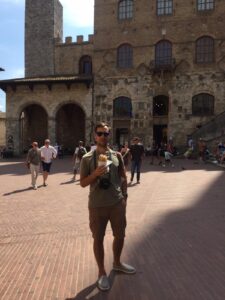
How to get to San Gimignano
Located 45 km northwest of Siena and 60 km south of Florence, San Gimignano is easy to reach by car. However, it is somewhat trickier (albeit very cheap) to get there by public transport. Sometimes, there is a direct bus from Siena to San Gimignano (just over an hour). Otherwise, take either the bus or the train (from either Siena or Florence) to Poggibonsi. The train from Siena to Poggibonsi takes about 20 minutes, whereas the train from Florence to Poggibonsi takes just over an hour. From Poggibonsi, take the bus 130 to San Gimignano (15-20 minutes). The bus station in Poggibonsi is right opposite the train station.
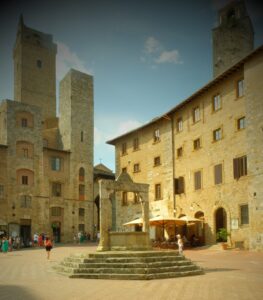
What to see in San Gimignano
The bus will drop you off at Piazzale Montemaggio. From there, get into the walled town through the Porta San Giovanni. As you walk on Via San Giovanni towards Piazza della Cisterna, you will realise why San Gimignano is also known as the Town of Fine Towers. If you’d like a coffee and/or something sweet, I would recommend the Pasticceria Armando e Marcella, on your left-hand side as you walk ahead, towards the Piazza della Cisterna.
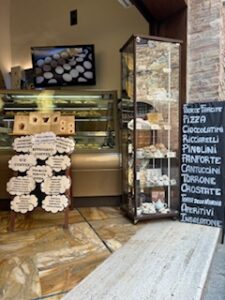
The Duomo, the Palazzo Communale and the Torre Grossa
Right next to the triangular Piazza della Cisterna, on the left, there’s Piazza del Duomo. On the left of the Duomo (also known as Collegiata di Santa Maria Assunta or Collegiate Church of the Assumption of the Blessed Virgin Mary), there’s the Palazzo Comunale with its 54-metre tall Torre Grossa. Built in 1310, Torre Grossa is the tallest tower in San Gimignano. If you climb the 160 steps to the top, you will be rewarded with panoramic views of the Tuscan town and its surrounding landscape.
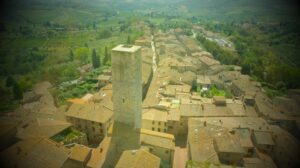
San Bartolo, Sant’Agostino and San Lorenzo di Ponte
Afterwards, walk on Via San Matteo towards the Porta San Matteo. On your right-hand side, there’s the Chiesa di San Bartolo.
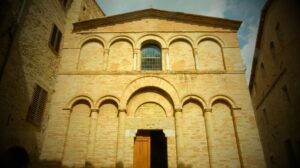
Right before you reach the Porta San Matteo, turn right on either Via San Martino or Via Cellolese, where there are several restaurants if you fancy a meal.
Continue to the Chiesa di Sant’Agostino, famous for its frescoes. Admission is free, but the church is closed from 12 to 3 pm.
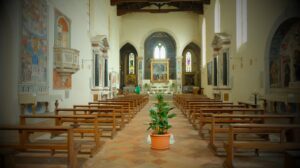
From there, walk on Via delle Romite towards the Chiesa di San Lorenzo in Ponte, on Via del Castello.
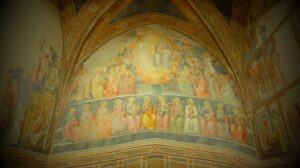
The San Gimignano pass costs 13 euros, is valid for 2 consecutive days and allows you access to several churches, monuments and museums in San Gimignano. Among those are the Duomo, the Palazzo Comunale, the Museo di Arte Sacra, the Museo Archeologico and the Chiesa di San Lorenzo in Ponte.
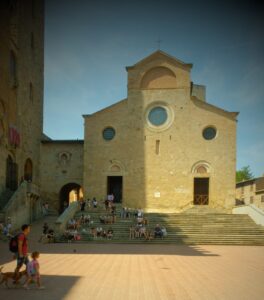
The best gelato in San Gimignano
From the Chiesa di San Lorenzo in Ponte, walk on Via del Castello back to the Piazza della Cisterna. Whilst there, make sure you have gelato at Gelateria Dondoli. There might be a queue outside but the wait won’t be too long and is definitely worth it. There are lots of flavours to choose from, but make sure you try the saffron-based ‘crema di Santa Fina’ for which Dondoli is famous.
In case you’re wondering who this flavour was named after, Santa Fina was born in San Gimignano, where she is venerated. After contracting a paralytic illness, she died at the age of 15 and is buried at the Duomo di San Gimignano.
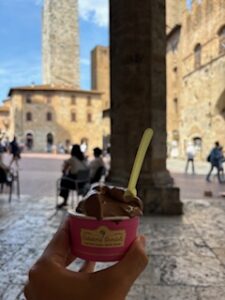
Further reading
To better prepare for my trip in Tuscany, I used the Lonely Planet Italy Travel Guide.
Over the next few months, I will post more about Florence, Siena and Lucca. In the meantime, here is an older post about Florence:
Summer in Florence: top 7 tips
Alex
(the Traveling Psychiatrist)